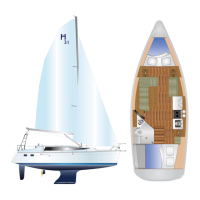SAFE BOATING TIPS
PAGE
17
ELECTRICAL SYSTEM (continued)
To minimize shock hazard, connect and
disconnect cable as follows:
1. Turn off the boat’s shore power con-
nection before connecting or discon-
necting shore power cable.
2. Connect shore power cable at the
boat first.
3. If polarity warning indicator is acti-
vated, immediately disconnect cable
and have the fault corrected by a
qualified electrician.
4. Disconnect shore power cable at
shore outlet first.
5. Close inlet cover tightly.
DO NOT ALTER SHORE POWER CA-
BLE CONNECTORS.
Storage: Your shore power cable set is
intended for use outdoors. To prolong
the life of the set, store indoors when
not in use.
General: The metallic parts of your ca-
ble set are made to resist corrosion. In a
salt-water environment, periodically wip-
ing the exposed parts with fresh water,
drying and spraying with a moisture re-
pellent can increase life of the product.
A soiled cable can be cleaned with a
grease cutting household detergent. A
periodic application of vinyl protector to
both ends will help to maintain cables
original appearance.
In case of salt water immersion, rinse
plug end and/or connector end thor-
oughly in fresh water, shake or blow out
excess water and allow to dry. Spray
with moisture repellent before re-use.
Do not allow your dockside power cord
to come in contact with the water. Never
operate any AC power tool or other
electrical equipment while you or the
device are in contact with the water, as
this may cause electrocution resulting in
shock or death.
When leaving port, disconnect the dock-
side power cord and turn the main DC
breaker on. This allows you to use the
ship’s lights and other equipment de-
signed to operate on direct current.
Keep in mind that your DC power
source is a 12-volt battery, just as with
your automobile, and it must be charged
regularly by operating the engine (or by
running the battery charger, if you have
that option installed). Unless a state of
charge is maintained, there may not be
enough power to operate the starter mo-
tor. Dangerous situations can result if
the engine cannot be started when
needed.
Make a regular visual check of batteries
to insure proper water level and inspect
terminals for signs of corrosion. If your
boat sits for long periods without use, it
is often a good idea to remove the bat-
teries and attach them to a trickle
charger to keep them fully charged and
ready to use.
EXPLOSION/FIRE HAZARD – ensure
adequate ventilation of battery to pre-
vent buildup of gases, especially hydro-
gen.
WHEN CHARGING THE BATTERY:
Battery electrolyte contains sulfuric
acid. Protect your eyes, skin and cloth-
ing. In case of contact, flush thoroughly
with water and get prompt medical at-
tention, especially if your eyes are af-
fected.
Batteries generate hydrogen gas that
can be highly explosive. Do not smoke
or allow flames or sparks near a battery,
especially during charging.
Charge the battery in a fully ventilated
place.

